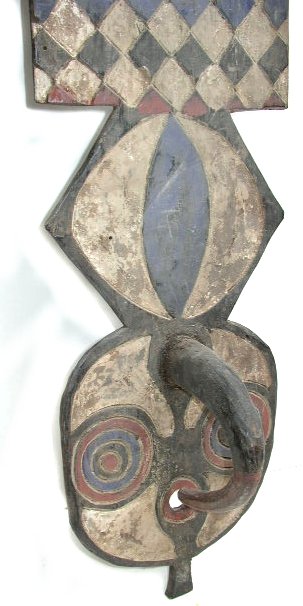
 Bwa,
Bwa, 
 Bwa,
Bwa,
Nwantantay plank mask. The southern Bwa
are called nyanegay, or “scarred Bwa”
because their faces and torsos are heavily scarred by patterns applied during initiation.
The southern Bwa abandoned the use of leaf masks to honor Dwo, the god of the wilderness,
and adopted the use of wooden masks from their Gurunsi neighbors. The masks represent
nature spirits or animals that family elders encountered in the wilderness and which watch
over their families. They
may represent antelopes, warthogs, wild buffalo, monkeys, crocodiles, serpents, fish,
birds, and insects, along with some human beings, and bush spirits who take on
supernatural forms. Both the scars on people’s faces and the patterns
on the masks represent the moral code or religious laws that the followers of these
spirits must obey if they are to receive the blessings of the spirit. A mask has a circular face with
geometric designs painted in vivid colors, and is surmounted by a large plank with a
crescent-shaped motif at the end. The eyes set off by concentric circles are intended to
recall an owl, and the hooked shape extending from its forehead alludes to the hornbill.
The motifs are symbols linked to Dwo and to the history of the clan. The mask is worn in
front of the face. They are differentiated only by the shape of the “horns”,
while the muzzle and protruding eyes remain mostly the same. The dancer looks through the
open hole of the mouth. These masks are thought to be inhabited by supernatural forces,
who act to benefit the clan, that possess them.
Material: wood
Size:
H. 80”, W. 9½”, D. 8”